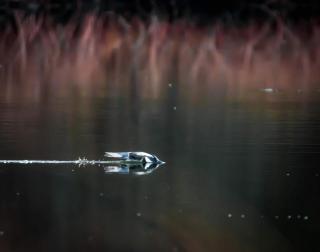The Belted Kingfisher

If you have paddled the Upper Cuyahoga River or walked along the path at Trail Lake Park, you are likely already familiar with the impressive Belted Kingfisher. Personally, this charismatic predator is on my list of favorite birds to watch. You’ll likely hear its loud, rattling call before you see it, but that glimpse is unforgettable. Kingfishers have a large head and impressive sharp bill that seems out of proportion to its robin-sized body. The Belted Kingfisher is one of a few bird species in which the female is more brightly colored than the male. The female has a bright chestnut-colored band across its chest that the males lack.
Kingfishers nest in burrows that they dig along earthen banks. Usually, 3-6 feet deep, these tunnels can be over 10 feet in length! They feed almost entirely on fish and crustaceans, but they will eat mollusks, insects, amphibians, reptiles, young birds, small mammals, and even berries. The Kingfisher looks for prey from a perch that overhangs the water. When it spots prey near the surface, it takes flight, dives, and grabs the prey in its bill with a pincer motion. One of my favorite fun facts about the Belted Kingfisher is that it produces pellets (like owls do) of undigestible bones. Scientists can dissect these pellets to learn about the kingfisher’s diet.
Belted Kingfishers are highly territorial. In fact, males will usually stay in their territory year-round if adequate food is available. I encourage you to bring your binoculars to a park near a body of water, then watch and listen for the Belted Kingfisher. When you are fortunate enough to spot one, please take the time to watch its impressive hunting techniques and interesting behaviors!

